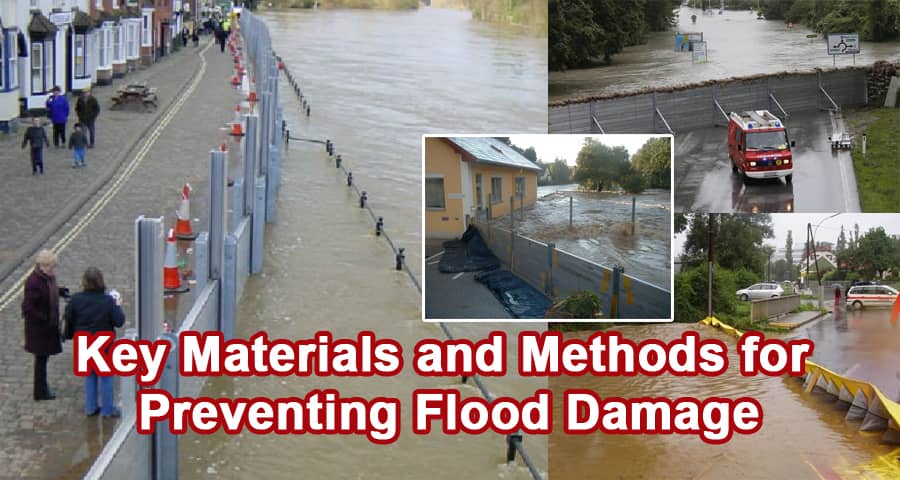Key Materials and Methods for Preventing Flood Damage

Flooding will inevitably occur at some point in your life, no matter where you live. People on the coast are not the only ones at risk from high water. Changing weather patterns and an increasing number of hard surfaces, such as roads & sidewalks, are increasing the risk of flooding among homeowners. It is important to note that disaster assistance is usually a repaid loan.
It is considered a flood damage resistant building material if it can withstand direct or prolonged flood water contact for 72 hours without significant damage.
Use Flood Resistant Materials
A flood resistant building material is non-damaged after being exposed to flood waters for at least 72 hours. In terms of damage, significant means more than a minor cosmetic repair.
Those parts of a home that lie below the 100 year flood level should be constructed with flood resistant materials. Concrete, closed cell, foam insulation, pressure-treated and marine grade plywood, and ceramic tile are all common flood resistant materials. You can also use stainless or galvanized steel hardware in these areas.
Key Methods to Protect Flood Damage
Waterproof Veneer Use on Outside Walls
Regardless of the depth of floodwaters, a home can be severely damaged if water reaches the interior. Add a waterproof veneer to the exterior walls of a home to protect it from shallow flooding. Several brick layers can be covered with a waterproof membrane. Additionally, the interior walls need to be changed as well.
Replacing batt insulation with washable closed-cell foam insulation will prevent flooding in areas below flood level. You always use exterior grade lumber for any wood blocking added inside the wall cavity.
Fuel Tanks Anchoring
Unanchored fuel tanks can easily be moved by floodwaters, posing a serious threat. Unanchored tanks outside a home can be driven into walls by flood waters or swept downstream, causing damage to other property.
Unanchored tanks in basements can be contaminated with oil when floodwaters move them. Attaching a tank to a large concrete slab heavy enough to resist floodwaters is one way of anchoring it. Regardless of whether a tank is inside or outside a house, this process can be applied to them all. Ground anchors can also be used to anchor outside tanks. Straps can be run over them and attached to them.
Well Protection from Contamination
Water from floods can carry hazardous or toxic materials, such as raw sewage, animal waste, oil, gasoline, solvents, or chemicals. It is possible for floodwater to contaminate well water and make it unsafe to drink or use, even after the floodwaters recede.
The casing of a well should be extended at least two feet above the highest known flood elevation in order to protect it from contamination. It's important to remember that potential contaminants shouldn't be stored within 100 feet of the well.
HVAC Equipment Utilization
Floodwaters can severely damage HVAC equipment such as furnaces and water heaters. Flood depth and the length of time the equipment remains underwater will influence the extent of damage.
Moving HVAC equipment from the basement or lower level of a flood prone home to the attic or upper level will protect it. There is also the less desirable option of leaving the equipment where it is and building a concrete or masonry block flood wall around it.
Back Flow Valves Installation in Sewer
During flooding, sewage can back up into homes through drain pipes in flood-prone areas. It is not only difficult to repair the damage caused by these backups, but they also pose a health risk. A back flow valve can prevent sewage backups by temporarily blocking drain pipes and preventing water from entering the house.
Electrical System Installation at Higher Place
Floodwater can damage electrical components like service panels, meters, switches, and outlets. Whenever they are submerged, even for a short period of time, they will probably need to be replaced. There is also the potential for fires caused by short circuits. There should be at least a foot of clearance above flood level for all electrical components, including wiring.
Wrapping it Up
Materials that are resistant to flood damage include concrete, ceramic tile, pressure treated plywood, pressure treated lumber, latex or bituminous, bricks, metals, etc. Floors and walls are constructed using different flood resistant materials.
Building elements built below the base flood elevation or 100 year flood level should be constructed with flood resistant materials. There is a 100 year flood elevated below the flood elevation, which means an occurrence of this flood in any given year has a 1 percent chance.
